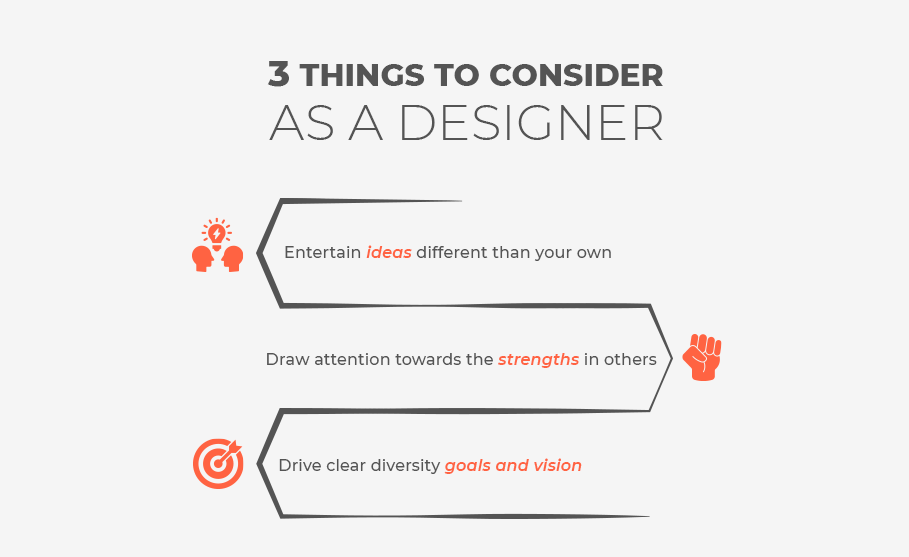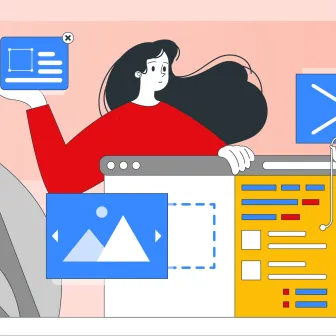“Diverse teams help you innovate better, make decisions quicker, and deliver more world-friendly products’’.
In the modern working world where competition is fierce, teams that include a diverse array of personality types, cultures, genders, and backgrounds are more successful than ever. Talking of the design field, the role of designs in companies is becoming less about visual appeal and more about hitting business goals and creating value for users. In other words, in the multidisciplinary field of design diversity exists on several levels and in large part, thereby making the work rich and the need for diverse teams even more imperative.
However, diversity being one of the most talked-about topics in industries is not easy to digest. That is to say, even if the organization with good intentions try to create and avail benefits of diverse design teams, the challenges lying ahead are a lot which can make diversity difficult to put into practice.
Therefore, in this article, we will be discussing factors how diverse design teams can improve the ability to innovate and yield better results. But before we hit the crux of the matter, it is important to start with the basics.
Diversity: A key driver to innovation
“United by purpose, not by personality or background type.”
Starting off with the statement the concept of diversity is evolving at an augmenting rate. The term Diversity is no longer limited to the formula of creating a heterogeneous workforce, rather it involves creating a workforce that can promise you innovative products, services, and business practices that can help a company stand out of the crowd. Moreover, building diverse teams can help companies gain a competitive edge in the marketplace. Since companies compete with each other at a global level, the definition of diversity and inclusion in design teams tends to shift in response to the difference in culture and market.
Diversity in the workplace is an implication that the organization employs a diverse team of people that are reflective of the society in which it exists and operates. Diversity is a blend of all the elements that make individuals unique from one another. As a matter of fact, employee diversity takes multiple forms which commonly include inborn traits of age, gender, ethnicity, race, and sexual orientation.
Members of diverse teams see things in a variety of ways, they are poised to recognize new and different market opportunities to better appreciate and shape their connections to the world. A diverse workforce brings different perspectives to unlock innovation that drives the market growth.
Let’s take a quick look at the reasons why the diverse teams are considered as the key drivers to innovation-

1. Diverse teams create more innovative ideas
The main intent to generate ideas is to unlock new ideas and new ways of working with a view to access previously undiscovered markets. A diverse team comprising different dimensions- culture, ethnicity, gender, sexuality, experience level, educational background, expertise, etc are more likely to create an inspiration that is more innovative and unconventional. Creating innovative ideas requires borrowing from different fields that diverse teams can lead to.
2. Diverse teams are better at making decisions
Drawing an idea and deciding which idea is to be tested are completely different scenarios. For your consideration, diverse teams are more capable of making decisions than homogenous ones. The reason being, diverse teams when increasing their level of difference, increases the chances of selecting an idea that can be a real game-changer. Because of the fact that diversity stretches a tram in an effective way, most companies support this idea.
3. Diverse teams lead to faster results
Since a diverse team is a compendium of different personalities, the execution of the idea is faster and even more cost-effective. The surface area of the resources is automatically expanded when a diverse team takes control over a project. Not to mention, a diverse team also navigates the enterprise on a tight budget and tap into networks that were unexplored as an individual.
Ways to embrace diversity in design teams
The journey of design teams often takes you into unknown and uncomfortable territory which any designer would wish to dodge. In a world going under continuous and intense transformation, the most rewarding thing you can come across is diversity. Diversity involves coming together of many different minds and personalities while adding richness to the experience. There is nothing wrong to say that diverse teams are like idea generation factories, literally build for innovation. The positive relationship between diversity and innovation is indisputable and is respected upfront by the team members.
Having different minds and personalities can often hinder the process of designing rather than to drive it. Yes, you heard it right. When different mindsets work together for a common cause, there exist chances of clashes between team members. However, with the right balance of values, this situation can be controlled and turned into a really big advantage. This situation can be illustrated by a model called the Competing Values Framework, devised by Quinn and Rohrbaugh. The model, basically categorized into “quadrants” depicts how different perspectives contribute to business values and what are their possible weak areas.

1. Collaborate
The first quadrant comprises people with characteristics that are committed to cooperating together based on shared values. These people encourage and build trust in each other to serve their long-term priorities. While a sense of unity might boost the purpose of that team, this on the other hand can be a big loophole. That is to say, the sense of unity can discourage people on an individual level who might think differently and would want to bring and share their ideas. Moreover, people are too busy looking for the future case, that they end up losing sight of the realities of constraints.
2. Create
When people with different dimensions come and work together, there are chances that they develop a sense of hesitation which often hinders the innovation process. Well, this quadrant can help those individuals to embrace their flaws, thereby leaving the fear to innovate at the doorstep. Creatives set trends, they don’t follow it. This is the sole reason why creatives see risk as an opportunity to bloom and embrace different ways of thinking. However, like every other thing, this quadrant suffers some drawbacks which include an impractical and illogical approach towards the execution of the ideas. It is observed that the flexibility in this quadrant often creates mayhem and leads to unprecedented situations.
3. Control
People in this quadrant aim to create reliable and efficient systems. Being a human with practical nature, they plan strategically for scaling and make regular, mandatory visits to their design to make sure that there is no room for error. The people in this quadrant have an eye for detail and can create opportunities out of the unexpected. However, too many control qualities on a team can make team members vulnerable since there is a heavy reliance on reliable systems. They are hostile to the idea of taking risks and fear to fall in a predicament.
4. Compete
The fourth and the last quadrant consists of people that are competitive in nature with a clear and determined focus on high performance. Excellent in decision-making, people here are well versed with how to make optimum utilization of the resources made available to them to fastrack the growth of the business. Competitors keep their focus on the pre-determined target of the business i.e. improving revenue and hitting target metrics. However, due to their priority to generate the immediate result, they are not compassionate towards the human side of the company's growth.
Things to consider as a designer
The job of a designer doesn’t revolve around the designing part only. In other words, designers are held responsible to contribute and create a work environment that constitutes a more diverse industry. Acknowledging different ideas and values contributed by people from all walks of life can help designers to manage the process effectively. Moreover, designers need to avoid discrimination and segregation among team members in the workplace.
When diversity is not managed actively, it creates an imbalance of values on a team and can give birth to several challenges. Therefore, as a designer, you need to pay attention to the following areas:

1. Entertain ideas different than your own
First things first, being a designer it is your sole responsibility to entertain ideas shared but other team members.The creativity that comes from diversity is highly capable of generating new ideas and improving ideas that are already in place. Listening to the ideas can be an interesting, engaging, and fun task. When you allow someone to speak something new and completely different, it develops a sense of acceptance in team members and thereby helps in improving efficiency.
2. Draw attention towards the strengths in others
Subsequently, you can help your co-workers by appreciating them for their unique strength and how their strength represents an opportunity for the company to grow and be more productive. Pointing out the strengths in others takes little effort and time but has a great impact on the overall efficiency of the work.
3. Drive clear diversity goals and vision
Setting up a clear diversity vision can help team members to connect to the overall objective of the business. This process should be done at the beginning of the project to acquire maximum efficiency. Furthermore, this process commits team members to understand how diversity impacts your role, and how your role impacts the overall success of the company’s diversity initiatives.
Conclusion
To conclude, the notion that increasing diversity in organizations results in greater innovation has been broadly and increasingly accepted. Teams with diverse perspectives can drive better innovation, foster creativity, and guide business strategies. Creating a diverse team is just the beginning of a new and more diverse design discipline. Also, having a diverse and inclusive workplace can unleash an explosion of ideas in your organization. Every employee owns and shares their different perspectives, therefore it becomes important for us to provide an environment wherein those differences can shine. Furthermore, if we (designers) as an individual come forward and commit to taking small action each day, we can surely leave a great impact as a group.
Keen to share your experiences (success or failure) in the workplace? Please contact us at [email protected] and our industry experts will inspire you to build a more diverse community.
Subscribe
Related Blogs
UX Best Practices for Website Integrations

Website Integrations determine whether users stay engaged or abandon a site. I experienced this firsthand with a delivery…
How design thinking acts as a problem solving strategy?

The concept of design thinking is gaining popularity these days since people across different industries are using it as a…
10 major challenges that come across during an agile transformation

It’s no longer a mystery that agile was created as a response to the various concerns that the traditional waterfall…




